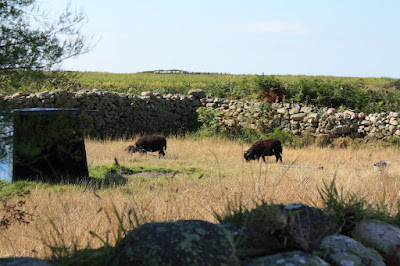
The farthest northeast point of France is the island of d'Ouessant. We set the clock for an early departure and managed to actually leave the house by 6:45 for the hour plus drive to the ferry. And in northwestern France, it is way dark at 6:45. Sometimes at 7:45 or 8:45!
 Taken from juts inside the boat -- watch your step, literally.
Taken from juts inside the boat -- watch your step, literally.
Ile d'Ouessant


We arrived at our ferry in Camaret-sur-mer in plenty of time, in fact enough to watch the sunrise. Soon enough we were scrambling aboart the boat which was tied up next to ancient steps. Forget OSHA and all those safety regs as we boarded -- just two burly guys who each took an arm and hoisted us in. Then it was an hour os so, and we arrived at a fairly windswept island with not alot going on except magnificent scenery. Not to worry about seeing the town -- it was all in the central square. We took a few minutes to walk to an "ecomuseum" which was really two small stone houses, one showing a traditional d'Ouessant home, the other a small collection of clothes and tools. Our first glimpse was of the haystack outside -- which was oblong, and covered with a braided net of hay.
The little house was a revelation. There were no interior walls. Instead, on entering, one is confronted with narrow hallways created by elevated boxes. The boxes are actually the bedrooms, just large enough to sleep in. Some had cupboards and small closets built in. Inside the sleeping boxes one would hang one's clothes and store personal items. Outside were benches and tables at one end for cooking, and the same repeated on the other end for a salon. A big selling point was that madame could rock the cradle without ever leaving the comfort of her bed. (Perhaps adding on was also easy -- just slap together another box!) And elevated in case of storms that might flood the island. Who knew that all these ruins of houses we had been seeing consisting of simple exterior walls were actually the entire house -- all the rest being wooden bedrooms. Outside the museum was a small paddock containing two rare d'Ouessant sheep, black and about the size of beagles with furry coats.

 braided hay
braided hay interior boxes in the house
interior boxes in the house bedbox and cradle
bedbox and cradle salon
salon The kitchen; behind the blue doors is a fireplace for cooking.
The kitchen; behind the blue doors is a fireplace for cooking. tiny sheep
tiny sheep
We headed back to town, had a forgettable lunch (must have been, since I forgot it), we slipped in side the church for a few moments, took in the extensive cemetery, famous for the many people killed in shipwrecks near the island, and found our tour bus for a three hour tour of the sights.



The first was one of the many lighthouses we were to see, but the impressive sights were actually two structures on the rocks. Both were access to foghorns, allowing people to access the foghorns even in treacherous weather. The first had a walkway in stone leading to a stone box. the second had a long bridge leading to a rock outcropping, which from the sea side had an access ladder.



 Care to climb up there in bad weather? Any weather?
Care to climb up there in bad weather? Any weather?

Our next stop was yet another lighthouse, this one having had in olden days a telepherique leading to it for supplies. The lighthouse is on the left; the other two columns made up part of the telepherique. Seeing the rocky waters even our very calm and warm day, it was easy to see how so many ships had come to grief.


Our next stop was a small cove with an impressive sea wall that was used by ships until relatively recently. Looking at the depths, and the variation of the tides, it would have been a nightmare. But perhaps you use what you have. Today there were sunbathers on the shore, children in the water (our guide said the water on a good day was about 60 degrees), and people riding bikes and picnicking here and there.


 A refreshing drink...
A refreshing drink... our ferry arrived...
our ferry arrived... a little help aboard...
a little help aboard... and our day in Ile d'Ouessant was over.
and our day in Ile d'Ouessant was over.
No comments:
Post a Comment